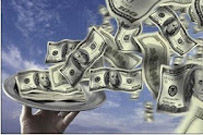Investment companies and investment mechanism in the United States
In 1980, in the United States in managing of investment companies were $ 60 billion, at 7 million of investor’s accounts. In 1994, the total amount of funds in investment companies exceeded $ 2 trillion, and the number of accounts has reached 80 million. According to rough estimates, these accounts hold about 33 percent of American families.
Investment companies
In the United States there are several types of investment companies, among which the most common are the so-called managerial companies. These companies are joint-stock companies, to invest money in which you can with buying their shares. The income of a  shareholder receives as dividends and interest on them, as well as the rising cost ofshares. Managerial companies are divided into open-end investment company or mutual funds and closed-end investment companies or trusts closed. In Russia the analogues of firsts were mutual funds, and the analog of last’s - joint-stock investment funds. Activities of American investment companies are regulated by the law for investment companies with an act of 1940. He provides for the minimum amount of assets for both types of investment companies in $ 100,000.
shareholder receives as dividends and interest on them, as well as the rising cost ofshares. Managerial companies are divided into open-end investment company or mutual funds and closed-end investment companies or trusts closed. In Russia the analogues of firsts were mutual funds, and the analog of last’s - joint-stock investment funds. Activities of American investment companies are regulated by the law for investment companies with an act of 1940. He provides for the minimum amount of assets for both types of investment companies in $ 100,000.
Public companies (mutual funds) have the right to issue only common shares, the income on which the investor cannot be determined in advance. It depends on the success of capital management fund. Open investment companies undertake to purchase issued shares from its shareholders. Thus, these shares can be bought only from the company and sold it the same. The cost of shares of the Fund is determined on the basis of the net asset value per 1 share.
Refer. Under the net assets means all capital of the Fund minus its expenses already incurred or must happen soon. Net asset value per 1 share is determined by dividing the net assets of the Fund by the number of shares issued. The net asset value of mutual funds is calculated at least 1 time a day. "Wall Street Journal" publishes the net asset value per share of mutual funds, during the previous day.
In the United States the most common mutual funds, because you can always sell the Fund's shares, in the long term, they demonstrated a yield higher than on bank deposits, moreover, information on their activities fully open to investors. Below, after a general review of the investment companies, we separately consider mutual funds.
Private companies (trusts closed type) are not required to buy back their shares from the shareholders. You can sell them on the stock exchange and the over-the-counter stock market. So the price for these shares is not calculated by the company, and is set depending on the supply and demand on the market. The closed company is entitled to issue, not only ordinary shares, but also  bonds and preferred shares, a percentage which is fixed for the investor. For an investor it is good in case of the company was not very successful and the average dividends low. In this case owner of preferred shares, benefits comparing with other shareholders. If the profit of foundation is high and dividends are paid and on income of the preferred shares owner is not affected: he will get as much previously fixed. In addition, the preferred shares do not participate in the management of the company.
bonds and preferred shares, a percentage which is fixed for the investor. For an investor it is good in case of the company was not very successful and the average dividends low. In this case owner of preferred shares, benefits comparing with other shareholders. If the profit of foundation is high and dividends are paid and on income of the preferred shares owner is not affected: he will get as much previously fixed. In addition, the preferred shares do not participate in the management of the company.
Private companies have a long history in the United States. During the time of "the great American depression," many investors suffered huge losses. As a result the concept of trusts closed type was forgotten for many years. The popularity of private companies again increased in 80 years. In 1980, the market was on the rise and has brought private companies huge profits. Among the private equity firms include most "insurance funds ' investment companies, investing the money in securities of any one country. From the point of view of profitability for the Americans is particularly interested in developing markets. Is known that invest money in developed countries more securely than in the developing world, but expect high returns in a stable economy. In countries that are just beginning to lift up their industry, the Outlook is much brighter, although accompanied by increased risk. By the way, today's Russia is one of developing markets. With such countries usually have a deal closed trusts, it is not surprisingly. To buy back shares of its shareholders, opened the Fund to sell some of its assets but, if these assets are securities of countries with unstable economies, this could cause serious difficulties. That is why the company prefers not to take on such a serious commitment, as buybacks of its shares. Of course, and emerging markets, as a rule, there are sector with reliable and liquid securities. For example, in Russia-it is market of Government securities. Therefore, for mutual funds in any country there is also space. From late 1985 to December 1993, the number of private companies investing in foreign securities has increased from 8 to 91, and the value of their assets has increased from $ 1.1 billion. to $24,9 billion. However, open company still developed more dynamically. During the same period, the number of mutual funds with overseas investments increased from 42 to 418 with increased their assets by $ 9.2 billion up to $ 151 billion.
Management companies, both public and private, can be diversified and not diversified.
To increase the reliability of the Investment Fund's money is invested in securities of many companies. This is called diversification. Diversification increases the reliability of the management company (the Fund), because if a company is losing 700,000 offset income from other businesses. But expect the Fund to diversify profit already, because if any one company has brought very high returns, its share of the total income of all enterprises.
To have the status of a diversified company, 75% of assets (property) of the company shall be invested in such a way that each company accounted for no more than 5% of the assets of the company and that the company has owned more than 10% of the voting shares of the company. Not diversified companies do not have such restrictions, so the investments in these companies are more risky, but potentially they could bring higher incomes.
In addition to these two types of investment companies in the United States, there are also so-called unit-trusts-a sort of foundations, structure of investments which is rigidly fixed in time and does not change. They enable citizens with modest savings, purchase large packages of securities. This allows you to buy securities cheaply and save on the costs of storing and processing transactions. Savings were also achieved through lack of remuneration of the Manager. In 1993 in the United States, there were about 15 000 unit trusts with assets of $ 107 billion.
Mutual funds
|
|
Of all the types of investment companies are the most popular mutual funds. In 1993, the total number of mutual funds totaled 4558, and their assets reached $2011 billion; closed investment companies was 512, and their assets were $ 124 billion.
They are similar to our mutual funds that buy back their own shares and that the value of a share is determined on the basis of the net assets. However, they are fundamentally different from Russian mutual funds, as are joint-stock companies. Shareholders have the right to vote on matters related to the selection of the Board of Directors, approval of investment policies and approval of a treaty  with the Governor. By 1940, the Board of Directors shall consist of at least 40% of non-managers of the company (external Director).
with the Governor. By 1940, the Board of Directors shall consist of at least 40% of non-managers of the company (external Director).
Direct management of the Fund is vested in the Governor-legal or physical person receiving his services for remuneration which generally depends on the net asset value of the Fund. Usually the Manager is the founder of the Fund. Remuneration of the Manager should be stated in the prospectus and is 0.25-3% of net assets (usually 0.5 -1%). the remuneration of the Manager is a core part of the costs of the Fund. the relationship with the Manager is built on the basis of the contract, which is subject to annual approval by the Board of Directors and general meeting of the shareholders.
Manager can manage several funds-in this case we speak of "the family" or group of funds. In the tables provided in the Wall Street Journal, all funds are names of management companies in alphabetical order: "Dean Witter"-15 funds, "Merrill Lynch"-30 funds, and so on. In late 1993, 67% of the assets of mutual funds were running only 25 companies. To attract more capital, one management company strives to create the foundations of all possible preferences. The choice of the investor depends on the preferences of varying degrees of reliability, profitability and liquidity. The higher yield, the lower reliability is. Different preferences are different types of securities. Why mutual funds are divided according to the types of securities in which they invest. For example, highly reliable, but are low-income stock funds investing in money market instruments (Government bonds, currency, etc.). Risky but high-stock funds invest in securities of young growing companies.
Very much in the success of the Fund depends on the Manager. The most effective managers in the United States and the world are John Templeton and George Soros. The last one is running the foundation, with total assets reached 11 billion in 1994; for the 1990-1994 period the average annual rate of return was 40%.
Typically, the Manager is measured by comparing the dynamics of the Fund's assets with any stock index such as the standard & poor's 500. The index is, roughly speaking, the stock market, which is calculated based on the cost of the most popular shares traded on that market. If their value grows, grows the index. If their value falls, index reduced too. As practice shows, the "one-up" the market in the long term is very difficult, so now most Governors use the tactics of passive investment (investment by index). In other words, the Fund's assets are invested in those securities that are used for calculation of the index. When you add or disappearance of any stocks from the index fund portfolio is adjusted. This method significantly reduces the costs of portfolio management. As a result, the popularity of index funds, the index has risen significantly.
Mutual funds have been very flexible Institute on the stock market, to satisfy the most diverse tastes and requests. Apparently so, they are gaining in popularity.



